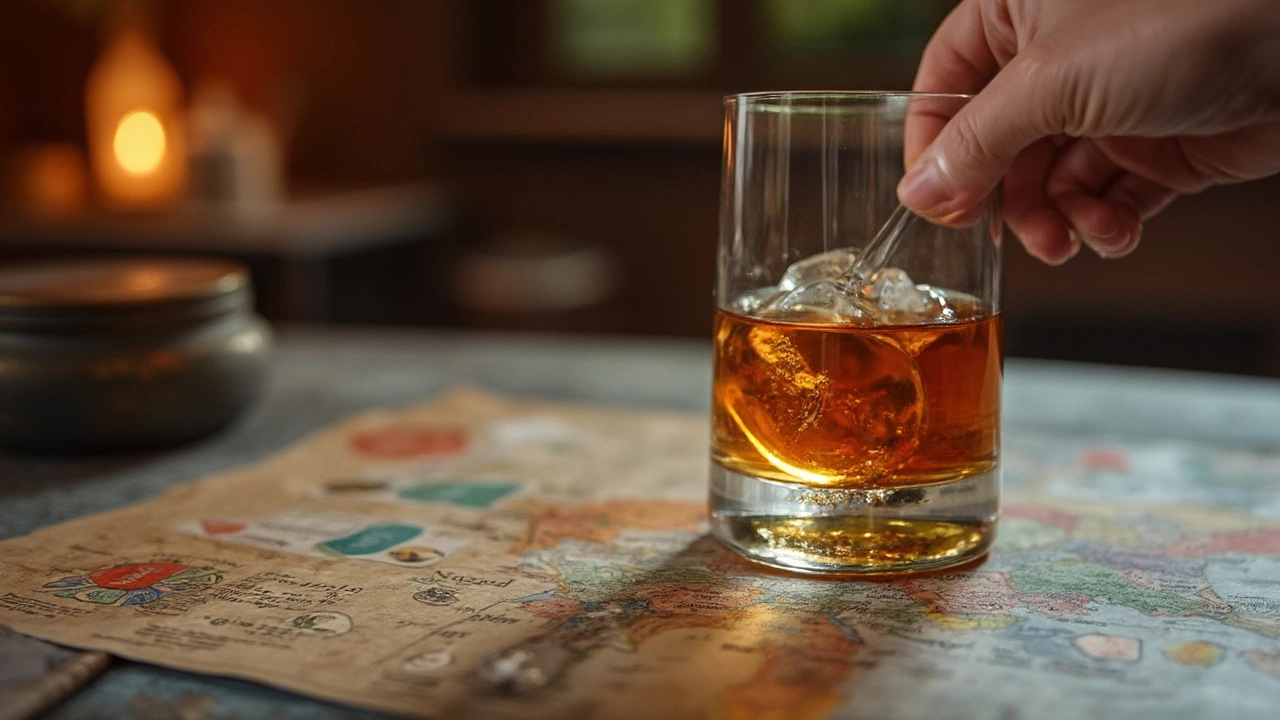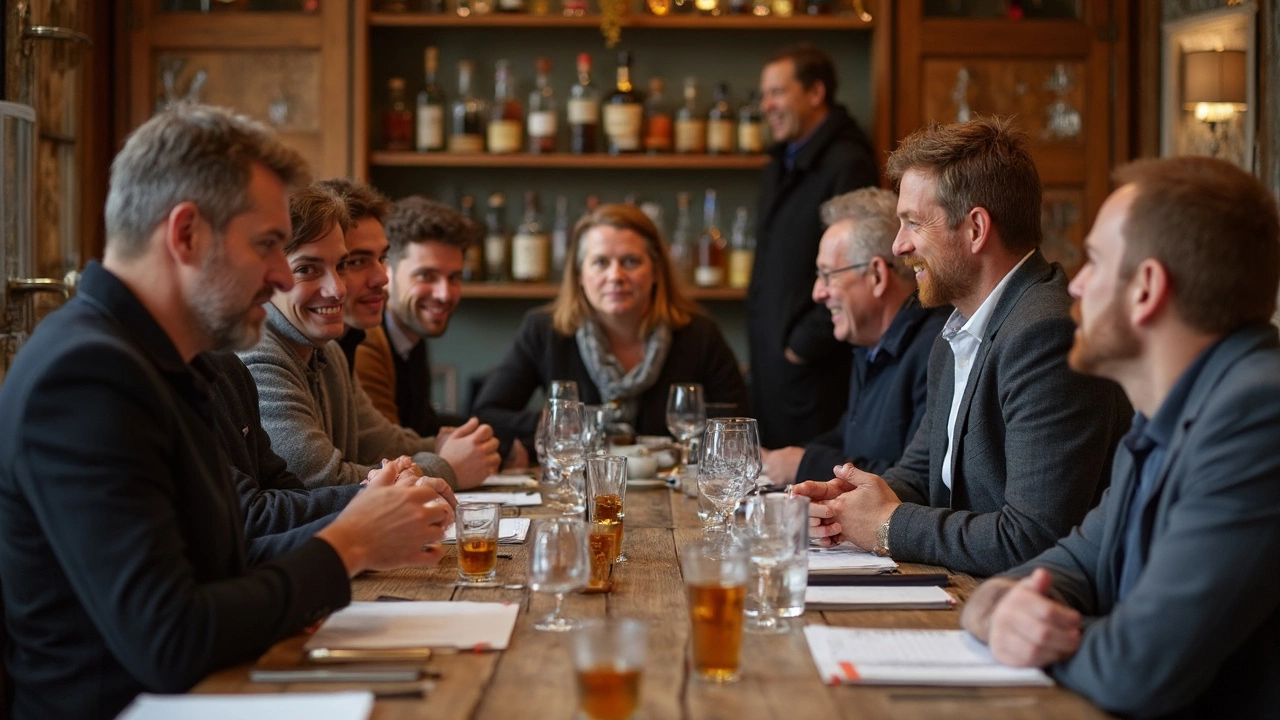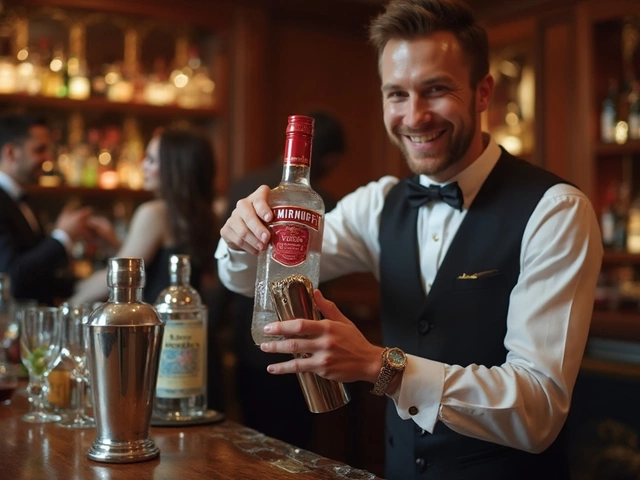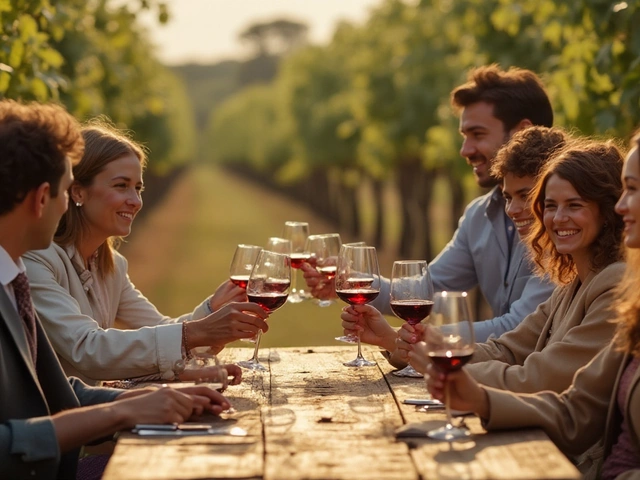Showing up at a whiskey tasting and not knowing what to do is a real fear for plenty of folks. Most of the time you’re not walking into a swanky secret club—just a bunch of regular people ready to talk and taste some good whiskey. The first thing you’ll notice: there’s usually a whole lineup of glasses, sometimes arranged by age or type. Nobody expects you to finish every pour, so breathe easy. The goal isn’t to leave wobbling.
It’s not about who can talk the fanciest or “get” every flavor note. If you’re new, start by noticing the basics: how does the whiskey look in the glass? Is it super dark, or more like pale gold? Swirl it gently and catch the smell—not just a big sniff, more like a little nudge. If it just smells like booze, that’s normal. Wait a second, and you might catch something else—vanilla, smoke, or something sweet. Trust your own nose, don’t stress about what others say.
- How a Whiskey Tasting Works
- Tasting Like a Pro: Step-by-Step
- Common Mistakes (and How to Dodge Them)
- Making the Most of Your Tasting
How a Whiskey Tasting Works
So, you walk in and see rows of glasses, maybe even a pour list. That first look can feel intimidating, but here’s what’s actually going on—there’s a plan behind every whiskey tasting. Usually, each glass is lined up in order, either from lightest to boldest, youngest to oldest, or by type (think bourbon, Scotch, or rye), all so your tastebuds don’t get slammed right from the start.
Most tastings start with a little intro by the host or expert who explains what you’ll be sampling. You're not expected to have a nose like Sherlock—just listen and pick up what you can. Fun fact: professional whiskey tastings rarely use shot glasses. They favor tulip-shaped glasses because that narrow shape helps you catch those tiny aromas that can hide behind the alcohol fumes.
Here’s what a classic tasting session looks like:
- You get a rundown of what’s being poured, usually with a quick history or a story about each bottle.
- Everyone gets small pours (usually around 20 mL) so you can try several types without overdoing it.
- No chugging—it’s all about sipping slow, talking about what you taste, and maybe even comparing notes with your friends or others at the table.
Don’t feel pressured to say you taste cinnamon or leather if all you get is ‘whiskey’. Most people start out tasting, well, whiskey, and build up from there. One cool tip: keeping a little water handy is normal. Adding a few drops can open up unexpected flavors in the glass.
And yes, at a whiskey tasting, spitting isn’t weird—lots of pros do it to keep their senses fresh, especially when lots of samples are involved. But if you like a pour, nobody’s stopping you from finishing it. The point is to explore, not rush, and just see what you like.
Tasting Like a Pro: Step-by-Step
Don’t worry, you don’t need a magic palate or a list of perfume terms to do this right. The truth is, even experienced tasters follow a simple process. Here’s how to sound like you belong—without making it weird.
- Look – Hold your glass against something plain, like a white napkin. Notice the color and clarity. Richer colors usually mean older whiskey or time spent in charred barrels, while younger stuff can look lighter. If the whiskey has a ton of legs (the slow streaks running down the glass), it often means more alcohol or richness.
- Smell – Stick your nose in gently, mouth open. Breathing in through both your nose and mouth softens the alcohol. Try moving the glass side-to-side—you’ll sometimes catch different scents in different spots. Ignore anyone saying you ‘must’ pick up a certain note; if it smells like fresh-baked bread or campfire to you, that’s legit.
- Taste – Sip, don’t gulp. Let it sit on your tongue for a bit, roll it around so you hit all your taste buds. Folks talk about ‘chewing’ the whiskey—just keep it in there a few seconds. You might notice flavors evolving, from sweet right away to spicy or bitter near the finish.
- Add water (if you want) – Here’s the trick a lot of beginners are afraid to try: add a few drops of water. This can mellow the sting and open up hidden flavors. You’ll see even old-timers using droppers. Totally normal, and often makes the tasting more interesting.
- Think about the finish – After you swallow, wait a bit. Is the flavor still hanging around? A long finish is often a sign of a well-made whiskey. Does it get warmer, sweeter, smokier? Take a second to notice it before you move to the next glass.
One more thing—don’t panic if you don’t taste exactly what the label says. Whiskey tasting is personal, not a competition. The *strong* flavor in whiskey tasting is noticing what hits your senses and enjoying the experience.

Common Mistakes (and How to Dodge Them)
People mess up at whiskey tasting events way more than you’d expect. Even folks who drink whiskey regularly can trip over rookie errors that totally kill the experience. Here’s what usually goes wrong and how to stay on the right track.
- Chugging instead of sipping: This one’s a classic. Whiskey tastings are about small sips. Knock back a pour and your taste buds get blasted, making it hard to notice flavors. Take tiny tastes and let the whiskey roll around your tongue.
- Overdoing it on the cologne or perfume: Anything that mixes with the scents ruins your nose for the real stuff. If you walk in smelling like a department store, you won’t pick up on subtle aromas—and neither will the people beside you.
- Comparing prices or showing off what you know: Nobody really cares who paid the most or who can name every Scottish distillery. The best tastings are about sharing what you pick up, not outsmarting the person next to you.
- Ignoring the water and snacks: Palate fatigue is real. If you taste a bunch of whiskeys in a row, everything starts to blend together. A sip of water (and maybe a bite of bread or cracker) between samples clears things out.
- Being scared to admit what you taste: People talk about tasting “worn leather” or “fresh rain.” Don’t pretend to taste what you don’t, and definitely don’t fake it. If all you get is “caramel” or “fire,” that’s honest and useful.
Stats back up how common these mistakes are. At industry events in Scotland and the U.S., about 40% of beginners over-pour their first glass, and nearly half forget to drink water between samples, according to the American Whiskey Trail group. Things get blurry quick if you ignore those basics.
| Mistake | How Often It Happens (%) | Easy Fix |
|---|---|---|
| Drinking too fast | 40 | Take small sips, slow down |
| No water between samples | 48 | Drink water between pours |
| Wearing strong fragrance | 20 | Skip perfume/cologne |
| Being afraid to share real thoughts | 35 | Be honest about what you taste |
When you dodge these mistakes, you actually taste more, remember more, and have way better conversations. No need to fake anything. Just relax, taste, and most importantly, ask questions if you’re lost. Nobody’s keeping score here.
Making the Most of Your Tasting
If you want to walk out of a whiskey tasting with more than just a buzz, you’ve got to do more than just sip. Most people remember about 20% of what they taste unless they write stuff down—that’s why the little notebooks on tasting tables exist. Jot quick notes about the flavors, finish, or how you felt about each glass. It doesn’t need to be fancy—"smoky, sweet, burns a little" works just fine. The act of writing it down helps you remember what you liked (or wouldn’t touch again).
Chatting with the people pouring the whiskey pays off, too. They usually know weird details about the distillery, like if they use old sherry casks or source their water from some famous Scottish river. Ask questions, even if they seem basic. If it’s a bigger event, you’ll often bump elbows with people who have tried way more bottles than you. Listen in—sometimes you’ll hear about hidden gems that aren’t even on your table that night.
Don’t skip the water table either. Adding a few drops of water into your whiskey—literally just a couple drops—can open up flavors you wouldn’t notice otherwise. It works especially well with high-proof stuff. Some places even have crackers or bread for you to reset your taste buds, which helps way more than you think.
Here’s a handy table to keep you organized while you’re tasting:
| Whiskey Name | Age | Region | Main Notes | Score (1-10) |
|---|---|---|---|---|
| Ardbeg 10 | 10 yrs | Islay | Peaty, smoky, earthy | |
| Redbreast 12 | 12 yrs | Ireland | Fruity, nutty, rich | |
| Buffalo Trace | Non-age | Kentucky | Vanilla, caramel, spice |
Fill in your own notes and scores as you go. This makes it easier to talk about what you liked (and why) later—plus, you actually remember what you drank the next day. Don’t be afraid to go back and compare two pours if you’re not sure. Some tastings even let you vote at the end, which can be more fun than you’d think.
The most important tip? Enjoy it. Nobody expects you to turn into an expert overnight. Pay attention, experiment a bit, and make it fun. If you walk out knowing what you enjoy, you’ve done it right.


